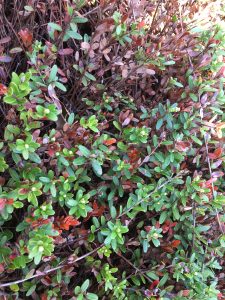Winter Damage in Northern Wisconsin
When I first volunteered for writing this article, I thought I had a good general answer for all the winter damage we are seeing in Northern Wisconsin marshes this year, based on initial observations. After scouting cranberries for seventeen plus years, I should have known better than thinking this. When it comes to winter damage there usually is no good general answer for when it occurs. What worked for one marsh didn’t work for another.
At first, I thought that the marshes that had better luck making good ice early fared better than those that had trouble making good ice later on, due to slush and snow. When I checked further, I found this wasn’t always the case. This killed that theory, but since Allison was expecting an article from me on this subject, I thought I should give my two cents worth.

Yes, I think slushy snow and poor ice did contribute to the problem in some cases, but it was just one of the many factors that came in to play. Some of the Winter Damage (orange vines) we see is from cold dry winds on frozen beds before or after the winter flood. Some of it is the standard leaf drop that we regularly see on edges of beds when water stands to long. The bulk of the damage is the large areas of brown vines and leaf drop and/or lots of side-shooting, with low numbers of fruiting uprights. What caused the damage in these areas is the question we are all trying to figure out.
A number of growers have said that the vines didn’t quite look as dormant as they should when winter set in. This could very well be a major contributing factor. The warmer than normal late autumns we have had the past few years prior to winter has caused problems for many of our perennial crops in Northern Wisconsin.
We can’t control the weather. Therefore, as Amaya Atucha pointed out in her May 27, 2020 CCMJ Video Interview, we should try to reduce other stress on vines, to help them handle adverse weather conditions better. Ways to reduce stress on vines include:
- Maintain or improve bed drainage. This will not only make the cranberries and their roots healthier, but will help get the water off quicker when pulling a flood.
- Fertilize at the proper time. See Amaya Atucha’s excellent article “Fertilization Recommendations for This Season” that was in last year’s CCMJ Volume 32, Issue 4. Current recommendations are to not start applying fertilizer until fruit set. Applying fertilizer earlier can cause over growth of vines, which in turn puts more stress on vines for overwintering.
- On edges of beds, or beds, that have little or no crop this year, cut way back on fertilizer. I know that these areas look tough, so the tendency is to give them extra fertilizer; but remember they are not producing a crop. Therefore, they do not need the normal amounts of fertilizer. Your goal is to just get them grown back for next year. Extra fertilizer, especially late Nitrogen, can set them up for excessive growth and the same problems again next year, due to delayed dormancy, etc.
- When vines are not being protected by sprinkler system or winter ice, and you are not sure on forecast for cold temperatures, or cold drying winds, I always recommend, that when in doubt go with the temporary flood; since once damage has occurred it is too late to go back.
- When flooding for harvest, cold temperatures, and/or cold dry winds only hold water for as long as need to, since if water is held too long it can reduce dormancy of vines.
- Try to stick to a regular sanding schedule when possible. Again, healthier vines and roots can handle winter stress better.
- Keep good records. They can be helpful when diagnosing problems, or planning for future years.
In summary, there is no easy “Cookie Cutter” solution to the Winter Damage problem. Also, what worked at one marsh may or may not have worked at another. I can only recommend that if you are a grower that had significant Winter Damage that you look back at last year, and try to remember if any thing stands out that could have put more stress on vines. Something may or may not stand out.
This article was posted in Cranberry and tagged Cranberries, winter damage.
